Scenario 3(b) Care Plans: Wound Care and Chemotherapy for Mr. Fraser
VerifiedAdded on 2020/06/06
|8
|2069
|523
Practical Assignment
AI Summary
This assignment provides two detailed care plans for Mr. Ron Fraser, addressing distinct medical scenarios. The first care plan focuses on wound healing following surgery for Acute Renal Injury (AKI), outlining nursing diagnoses, goals, priority actions, and rationales. It emphasizes infection risk, wound care, and patient education. The second care plan centers on chemotherapy treatment for stage 3 cancer, addressing potential complications such as pain, infection risk, and side effects. It details nursing interventions for pain management, monitoring, and supportive care, including assessments, medication management, and patient comfort strategies. Both plans reference supporting literature and emphasize the importance of continuous assessment and patient-centered care.
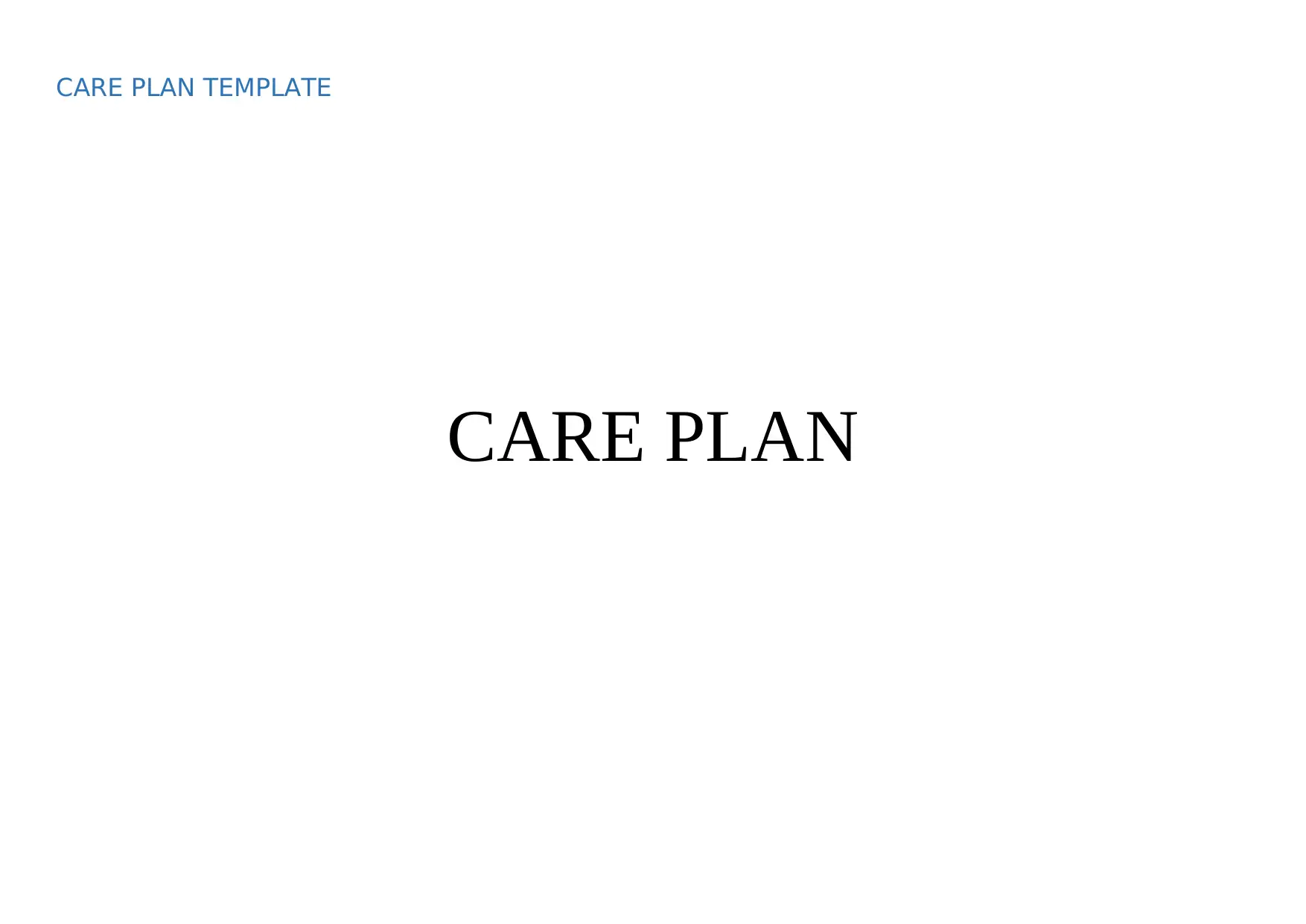
CARE PLAN TEMPLATE
CARE PLAN
CARE PLAN
Paraphrase This Document
Need a fresh take? Get an instant paraphrase of this document with our AI Paraphraser
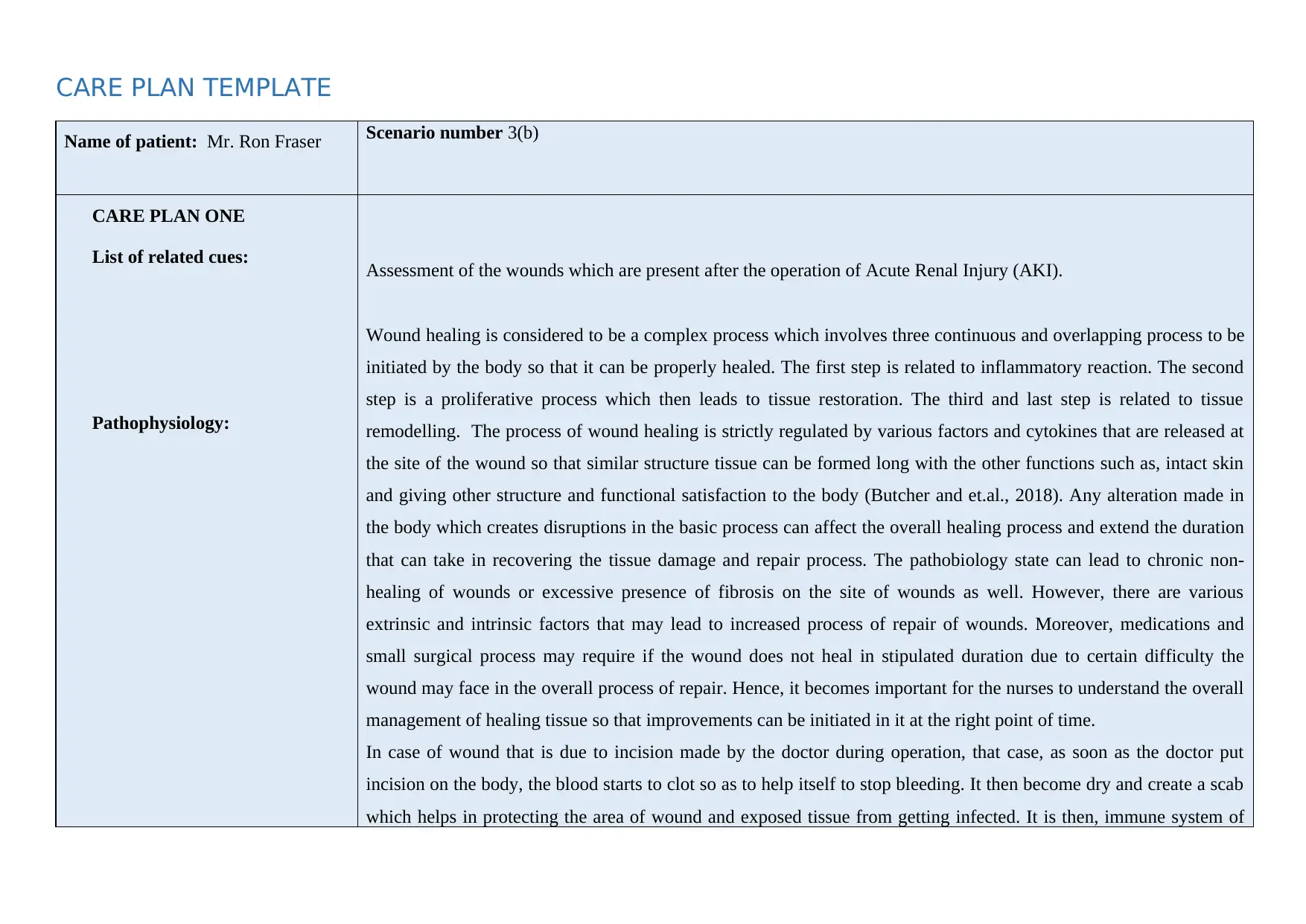
CARE PLAN TEMPLATE
Name of patient: Mr. Ron Fraser Scenario number 3(b)
CARE PLAN ONE
List of related cues:
Pathophysiology:
Assessment of the wounds which are present after the operation of Acute Renal Injury (AKI).
Wound healing is considered to be a complex process which involves three continuous and overlapping process to be
initiated by the body so that it can be properly healed. The first step is related to inflammatory reaction. The second
step is a proliferative process which then leads to tissue restoration. The third and last step is related to tissue
remodelling. The process of wound healing is strictly regulated by various factors and cytokines that are released at
the site of the wound so that similar structure tissue can be formed long with the other functions such as, intact skin
and giving other structure and functional satisfaction to the body (Butcher and et.al., 2018). Any alteration made in
the body which creates disruptions in the basic process can affect the overall healing process and extend the duration
that can take in recovering the tissue damage and repair process. The pathobiology state can lead to chronic non-
healing of wounds or excessive presence of fibrosis on the site of wounds as well. However, there are various
extrinsic and intrinsic factors that may lead to increased process of repair of wounds. Moreover, medications and
small surgical process may require if the wound does not heal in stipulated duration due to certain difficulty the
wound may face in the overall process of repair. Hence, it becomes important for the nurses to understand the overall
management of healing tissue so that improvements can be initiated in it at the right point of time.
In case of wound that is due to incision made by the doctor during operation, that case, as soon as the doctor put
incision on the body, the blood starts to clot so as to help itself to stop bleeding. It then become dry and create a scab
which helps in protecting the area of wound and exposed tissue from getting infected. It is then, immune system of
Name of patient: Mr. Ron Fraser Scenario number 3(b)
CARE PLAN ONE
List of related cues:
Pathophysiology:
Assessment of the wounds which are present after the operation of Acute Renal Injury (AKI).
Wound healing is considered to be a complex process which involves three continuous and overlapping process to be
initiated by the body so that it can be properly healed. The first step is related to inflammatory reaction. The second
step is a proliferative process which then leads to tissue restoration. The third and last step is related to tissue
remodelling. The process of wound healing is strictly regulated by various factors and cytokines that are released at
the site of the wound so that similar structure tissue can be formed long with the other functions such as, intact skin
and giving other structure and functional satisfaction to the body (Butcher and et.al., 2018). Any alteration made in
the body which creates disruptions in the basic process can affect the overall healing process and extend the duration
that can take in recovering the tissue damage and repair process. The pathobiology state can lead to chronic non-
healing of wounds or excessive presence of fibrosis on the site of wounds as well. However, there are various
extrinsic and intrinsic factors that may lead to increased process of repair of wounds. Moreover, medications and
small surgical process may require if the wound does not heal in stipulated duration due to certain difficulty the
wound may face in the overall process of repair. Hence, it becomes important for the nurses to understand the overall
management of healing tissue so that improvements can be initiated in it at the right point of time.
In case of wound that is due to incision made by the doctor during operation, that case, as soon as the doctor put
incision on the body, the blood starts to clot so as to help itself to stop bleeding. It then become dry and create a scab
which helps in protecting the area of wound and exposed tissue from getting infected. It is then, immune system of
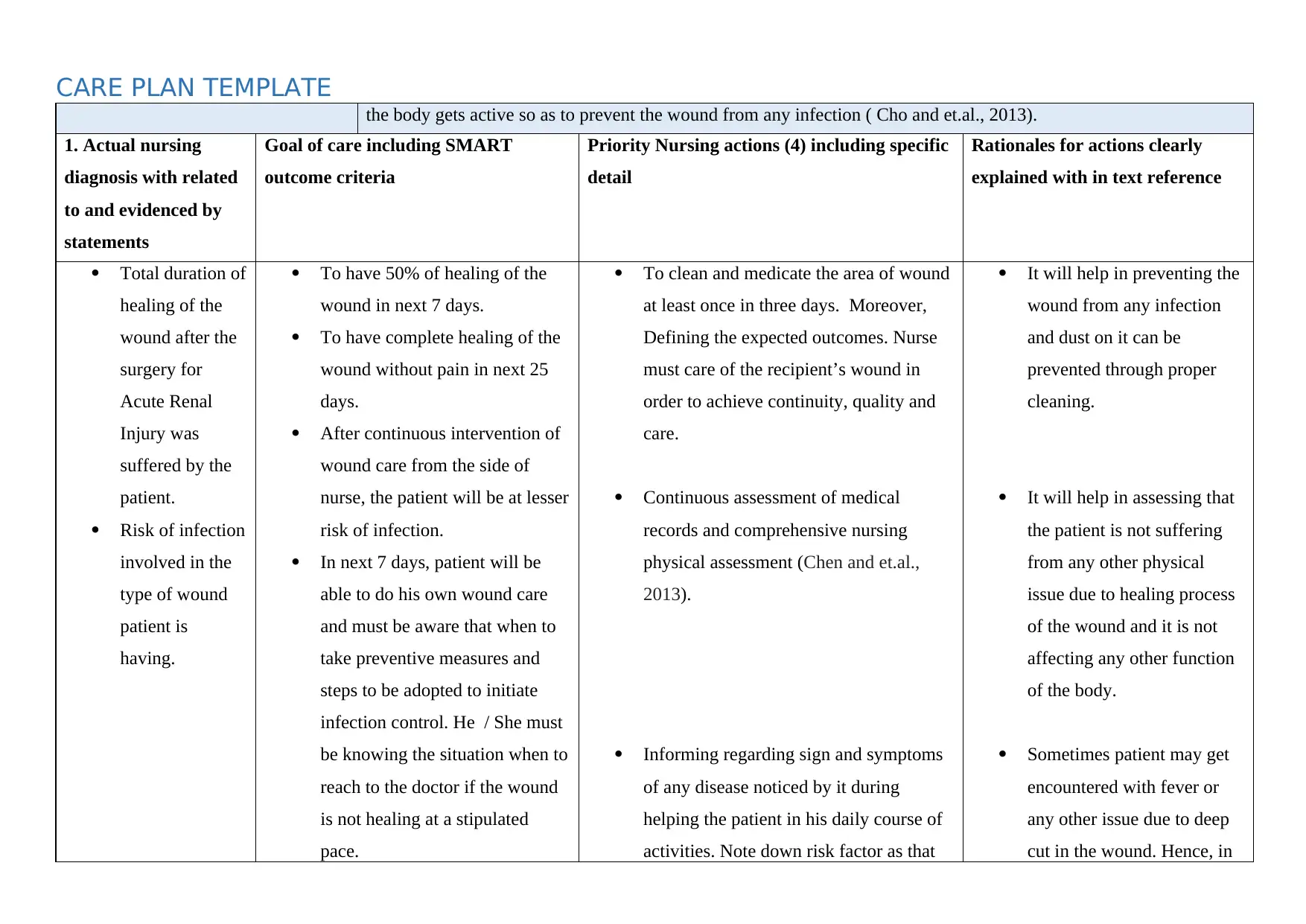
CARE PLAN TEMPLATE the body gets active so as to prevent the wound from any infection ( Cho and et.al., 2013).
1. Actual nursing
diagnosis with related
to and evidenced by
statements
Goal of care including SMART
outcome criteria
Priority Nursing actions (4) including specific
detail
Rationales for actions clearly
explained with in text reference
Total duration of
healing of the
wound after the
surgery for
Acute Renal
Injury was
suffered by the
patient.
Risk of infection
involved in the
type of wound
patient is
having.
To have 50% of healing of the
wound in next 7 days.
To have complete healing of the
wound without pain in next 25
days.
After continuous intervention of
wound care from the side of
nurse, the patient will be at lesser
risk of infection.
In next 7 days, patient will be
able to do his own wound care
and must be aware that when to
take preventive measures and
steps to be adopted to initiate
infection control. He / She must
be knowing the situation when to
reach to the doctor if the wound
is not healing at a stipulated
pace.
To clean and medicate the area of wound
at least once in three days. Moreover,
Defining the expected outcomes. Nurse
must care of the recipient’s wound in
order to achieve continuity, quality and
care.
Continuous assessment of medical
records and comprehensive nursing
physical assessment (Chen and et.al.,
2013).
Informing regarding sign and symptoms
of any disease noticed by it during
helping the patient in his daily course of
activities. Note down risk factor as that
It will help in preventing the
wound from any infection
and dust on it can be
prevented through proper
cleaning.
It will help in assessing that
the patient is not suffering
from any other physical
issue due to healing process
of the wound and it is not
affecting any other function
of the body.
Sometimes patient may get
encountered with fever or
any other issue due to deep
cut in the wound. Hence, in
1. Actual nursing
diagnosis with related
to and evidenced by
statements
Goal of care including SMART
outcome criteria
Priority Nursing actions (4) including specific
detail
Rationales for actions clearly
explained with in text reference
Total duration of
healing of the
wound after the
surgery for
Acute Renal
Injury was
suffered by the
patient.
Risk of infection
involved in the
type of wound
patient is
having.
To have 50% of healing of the
wound in next 7 days.
To have complete healing of the
wound without pain in next 25
days.
After continuous intervention of
wound care from the side of
nurse, the patient will be at lesser
risk of infection.
In next 7 days, patient will be
able to do his own wound care
and must be aware that when to
take preventive measures and
steps to be adopted to initiate
infection control. He / She must
be knowing the situation when to
reach to the doctor if the wound
is not healing at a stipulated
pace.
To clean and medicate the area of wound
at least once in three days. Moreover,
Defining the expected outcomes. Nurse
must care of the recipient’s wound in
order to achieve continuity, quality and
care.
Continuous assessment of medical
records and comprehensive nursing
physical assessment (Chen and et.al.,
2013).
Informing regarding sign and symptoms
of any disease noticed by it during
helping the patient in his daily course of
activities. Note down risk factor as that
It will help in preventing the
wound from any infection
and dust on it can be
prevented through proper
cleaning.
It will help in assessing that
the patient is not suffering
from any other physical
issue due to healing process
of the wound and it is not
affecting any other function
of the body.
Sometimes patient may get
encountered with fever or
any other issue due to deep
cut in the wound. Hence, in
⊘ This is a preview!⊘
Do you want full access?
Subscribe today to unlock all pages.

Trusted by 1+ million students worldwide
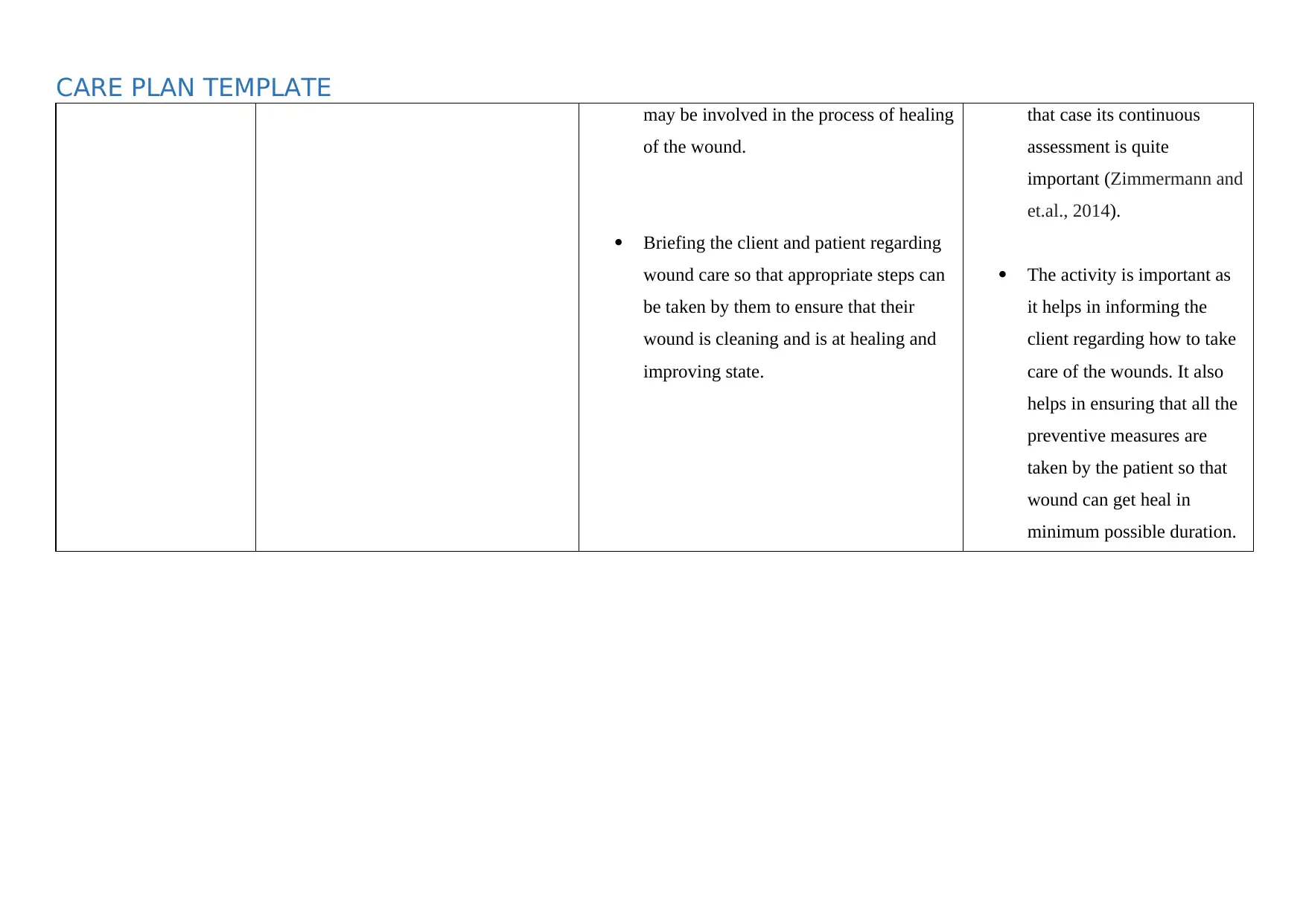
CARE PLAN TEMPLATE may be involved in the process of healing
of the wound.
Briefing the client and patient regarding
wound care so that appropriate steps can
be taken by them to ensure that their
wound is cleaning and is at healing and
improving state.
that case its continuous
assessment is quite
important (Zimmermann and
et.al., 2014).
The activity is important as
it helps in informing the
client regarding how to take
care of the wounds. It also
helps in ensuring that all the
preventive measures are
taken by the patient so that
wound can get heal in
minimum possible duration.
of the wound.
Briefing the client and patient regarding
wound care so that appropriate steps can
be taken by them to ensure that their
wound is cleaning and is at healing and
improving state.
that case its continuous
assessment is quite
important (Zimmermann and
et.al., 2014).
The activity is important as
it helps in informing the
client regarding how to take
care of the wounds. It also
helps in ensuring that all the
preventive measures are
taken by the patient so that
wound can get heal in
minimum possible duration.
Paraphrase This Document
Need a fresh take? Get an instant paraphrase of this document with our AI Paraphraser
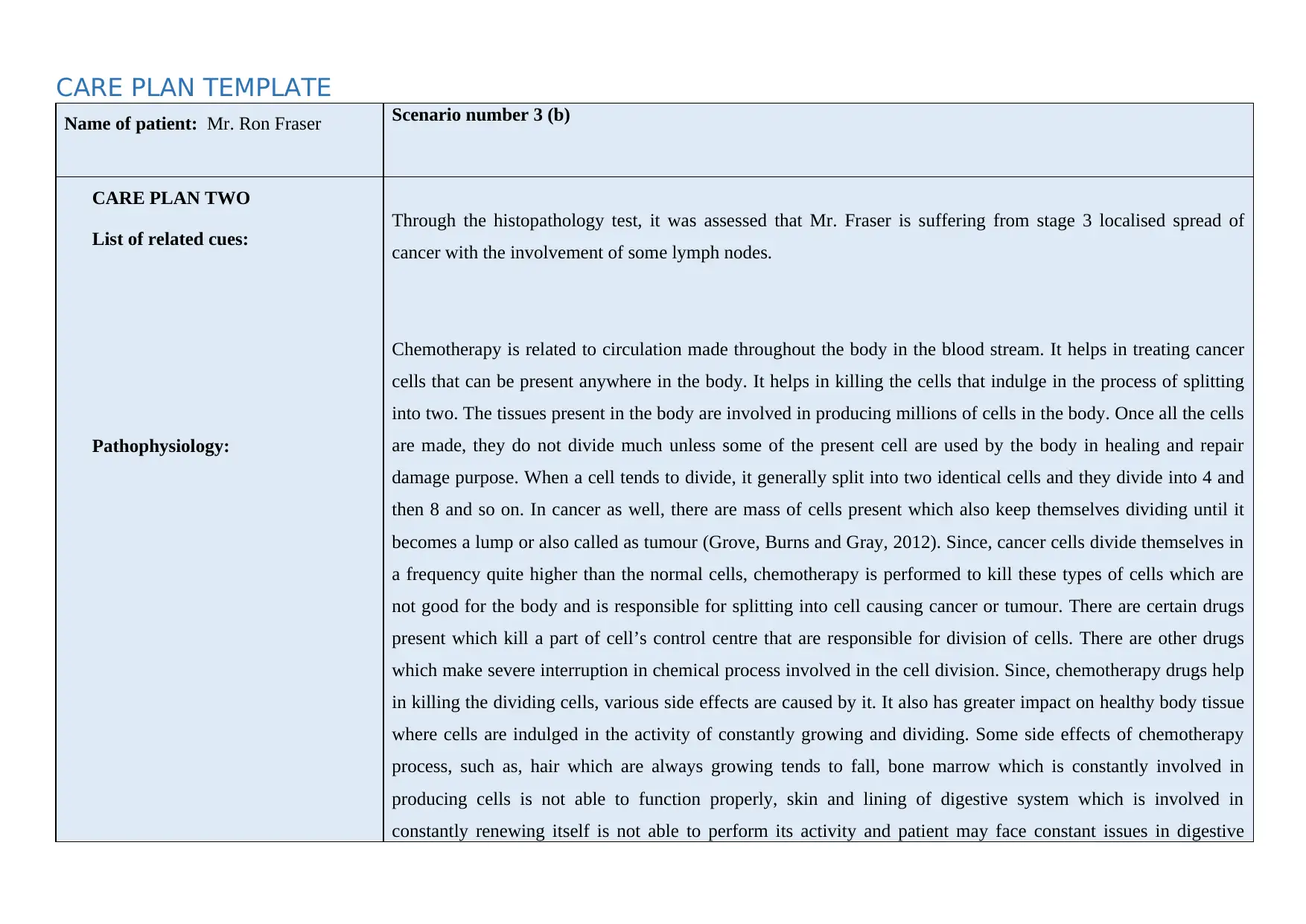
CARE PLAN TEMPLATE
Name of patient: Mr. Ron Fraser Scenario number 3 (b)
CARE PLAN TWO
List of related cues:
Pathophysiology:
Through the histopathology test, it was assessed that Mr. Fraser is suffering from stage 3 localised spread of
cancer with the involvement of some lymph nodes.
Chemotherapy is related to circulation made throughout the body in the blood stream. It helps in treating cancer
cells that can be present anywhere in the body. It helps in killing the cells that indulge in the process of splitting
into two. The tissues present in the body are involved in producing millions of cells in the body. Once all the cells
are made, they do not divide much unless some of the present cell are used by the body in healing and repair
damage purpose. When a cell tends to divide, it generally split into two identical cells and they divide into 4 and
then 8 and so on. In cancer as well, there are mass of cells present which also keep themselves dividing until it
becomes a lump or also called as tumour (Grove, Burns and Gray, 2012). Since, cancer cells divide themselves in
a frequency quite higher than the normal cells, chemotherapy is performed to kill these types of cells which are
not good for the body and is responsible for splitting into cell causing cancer or tumour. There are certain drugs
present which kill a part of cell’s control centre that are responsible for division of cells. There are other drugs
which make severe interruption in chemical process involved in the cell division. Since, chemotherapy drugs help
in killing the dividing cells, various side effects are caused by it. It also has greater impact on healthy body tissue
where cells are indulged in the activity of constantly growing and dividing. Some side effects of chemotherapy
process, such as, hair which are always growing tends to fall, bone marrow which is constantly involved in
producing cells is not able to function properly, skin and lining of digestive system which is involved in
constantly renewing itself is not able to perform its activity and patient may face constant issues in digestive
Name of patient: Mr. Ron Fraser Scenario number 3 (b)
CARE PLAN TWO
List of related cues:
Pathophysiology:
Through the histopathology test, it was assessed that Mr. Fraser is suffering from stage 3 localised spread of
cancer with the involvement of some lymph nodes.
Chemotherapy is related to circulation made throughout the body in the blood stream. It helps in treating cancer
cells that can be present anywhere in the body. It helps in killing the cells that indulge in the process of splitting
into two. The tissues present in the body are involved in producing millions of cells in the body. Once all the cells
are made, they do not divide much unless some of the present cell are used by the body in healing and repair
damage purpose. When a cell tends to divide, it generally split into two identical cells and they divide into 4 and
then 8 and so on. In cancer as well, there are mass of cells present which also keep themselves dividing until it
becomes a lump or also called as tumour (Grove, Burns and Gray, 2012). Since, cancer cells divide themselves in
a frequency quite higher than the normal cells, chemotherapy is performed to kill these types of cells which are
not good for the body and is responsible for splitting into cell causing cancer or tumour. There are certain drugs
present which kill a part of cell’s control centre that are responsible for division of cells. There are other drugs
which make severe interruption in chemical process involved in the cell division. Since, chemotherapy drugs help
in killing the dividing cells, various side effects are caused by it. It also has greater impact on healthy body tissue
where cells are indulged in the activity of constantly growing and dividing. Some side effects of chemotherapy
process, such as, hair which are always growing tends to fall, bone marrow which is constantly involved in
producing cells is not able to function properly, skin and lining of digestive system which is involved in
constantly renewing itself is not able to perform its activity and patient may face constant issues in digestive
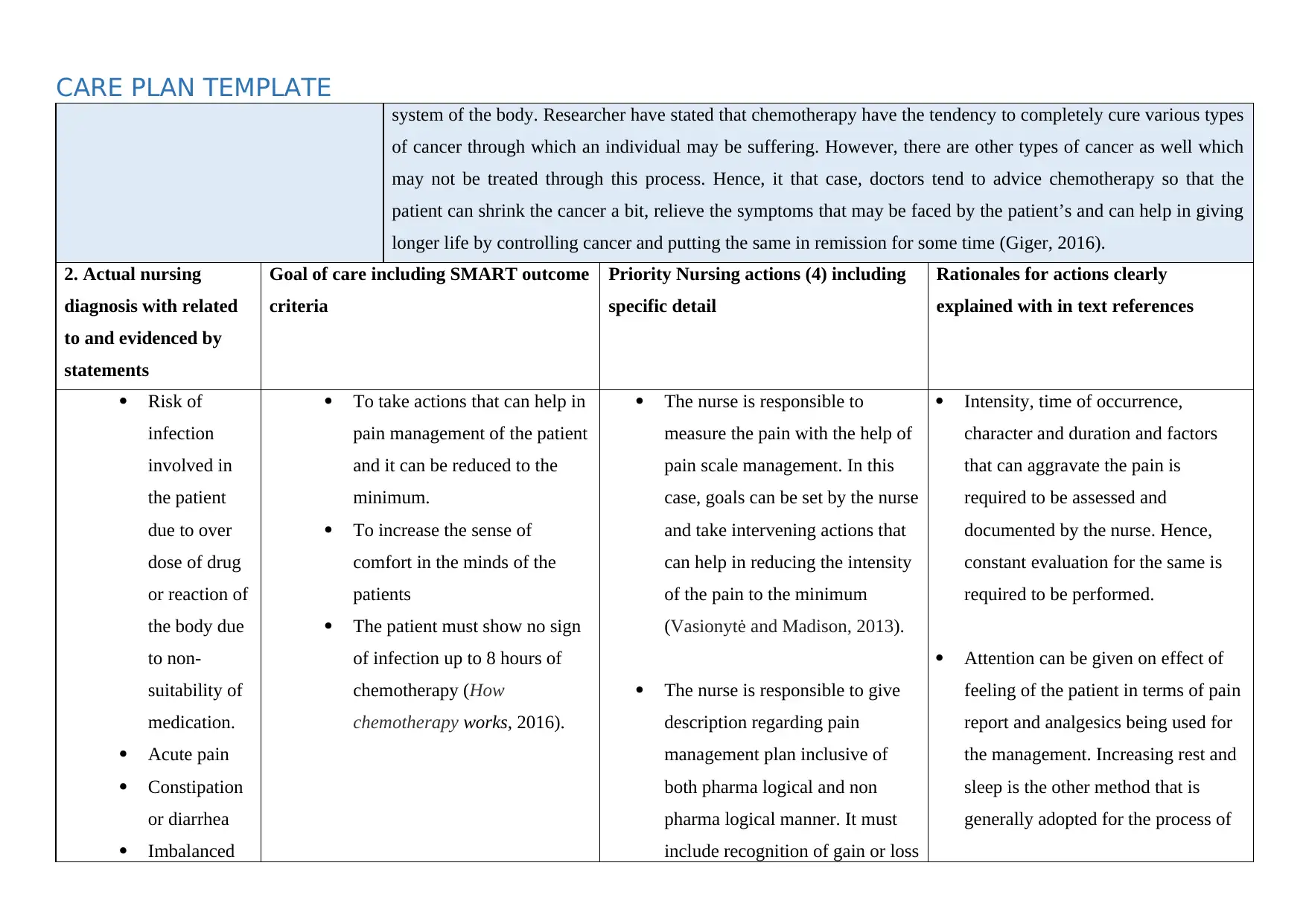
CARE PLAN TEMPLATE system of the body. Researcher have stated that chemotherapy have the tendency to completely cure various types
of cancer through which an individual may be suffering. However, there are other types of cancer as well which
may not be treated through this process. Hence, it that case, doctors tend to advice chemotherapy so that the
patient can shrink the cancer a bit, relieve the symptoms that may be faced by the patient’s and can help in giving
longer life by controlling cancer and putting the same in remission for some time (Giger, 2016).
2. Actual nursing
diagnosis with related
to and evidenced by
statements
Goal of care including SMART outcome
criteria
Priority Nursing actions (4) including
specific detail
Rationales for actions clearly
explained with in text references
Risk of
infection
involved in
the patient
due to over
dose of drug
or reaction of
the body due
to non-
suitability of
medication.
Acute pain
Constipation
or diarrhea
Imbalanced
To take actions that can help in
pain management of the patient
and it can be reduced to the
minimum.
To increase the sense of
comfort in the minds of the
patients
The patient must show no sign
of infection up to 8 hours of
chemotherapy (How
chemotherapy works, 2016).
The nurse is responsible to
measure the pain with the help of
pain scale management. In this
case, goals can be set by the nurse
and take intervening actions that
can help in reducing the intensity
of the pain to the minimum
(Vasionytė and Madison, 2013).
The nurse is responsible to give
description regarding pain
management plan inclusive of
both pharma logical and non
pharma logical manner. It must
include recognition of gain or loss
Intensity, time of occurrence,
character and duration and factors
that can aggravate the pain is
required to be assessed and
documented by the nurse. Hence,
constant evaluation for the same is
required to be performed.
Attention can be given on effect of
feeling of the patient in terms of pain
report and analgesics being used for
the management. Increasing rest and
sleep is the other method that is
generally adopted for the process of
of cancer through which an individual may be suffering. However, there are other types of cancer as well which
may not be treated through this process. Hence, it that case, doctors tend to advice chemotherapy so that the
patient can shrink the cancer a bit, relieve the symptoms that may be faced by the patient’s and can help in giving
longer life by controlling cancer and putting the same in remission for some time (Giger, 2016).
2. Actual nursing
diagnosis with related
to and evidenced by
statements
Goal of care including SMART outcome
criteria
Priority Nursing actions (4) including
specific detail
Rationales for actions clearly
explained with in text references
Risk of
infection
involved in
the patient
due to over
dose of drug
or reaction of
the body due
to non-
suitability of
medication.
Acute pain
Constipation
or diarrhea
Imbalanced
To take actions that can help in
pain management of the patient
and it can be reduced to the
minimum.
To increase the sense of
comfort in the minds of the
patients
The patient must show no sign
of infection up to 8 hours of
chemotherapy (How
chemotherapy works, 2016).
The nurse is responsible to
measure the pain with the help of
pain scale management. In this
case, goals can be set by the nurse
and take intervening actions that
can help in reducing the intensity
of the pain to the minimum
(Vasionytė and Madison, 2013).
The nurse is responsible to give
description regarding pain
management plan inclusive of
both pharma logical and non
pharma logical manner. It must
include recognition of gain or loss
Intensity, time of occurrence,
character and duration and factors
that can aggravate the pain is
required to be assessed and
documented by the nurse. Hence,
constant evaluation for the same is
required to be performed.
Attention can be given on effect of
feeling of the patient in terms of pain
report and analgesics being used for
the management. Increasing rest and
sleep is the other method that is
generally adopted for the process of
⊘ This is a preview!⊘
Do you want full access?
Subscribe today to unlock all pages.

Trusted by 1+ million students worldwide

CARE PLAN TEMPLATE
intake of
nutrition.
Ineffective
breathing
Fatigue
Impaired oral
mucous
in the case of pain management
medications.
Demonstrating the ability that can
help in calming down the patient and
relaxing him so that he / she can get
the courage to manage the pain he /
she can face at the time of
chemotherapy.
Assessing the drugs that might be
required for the patient to make him
reach to a better position in
comparison to the present one.
management of pain.
Controlling environmental factors is
the another method that can be used
by the nurses with the aim to
promote pain management strategies.
It helps in giving courage to the
patient to deal with the process of
pain that may take place at the time
of chemotherapy (Stuart, 2014).
Analgesics is the best method.
However, it may not work in all the
cases.
intake of
nutrition.
Ineffective
breathing
Fatigue
Impaired oral
mucous
in the case of pain management
medications.
Demonstrating the ability that can
help in calming down the patient and
relaxing him so that he / she can get
the courage to manage the pain he /
she can face at the time of
chemotherapy.
Assessing the drugs that might be
required for the patient to make him
reach to a better position in
comparison to the present one.
management of pain.
Controlling environmental factors is
the another method that can be used
by the nurses with the aim to
promote pain management strategies.
It helps in giving courage to the
patient to deal with the process of
pain that may take place at the time
of chemotherapy (Stuart, 2014).
Analgesics is the best method.
However, it may not work in all the
cases.
Paraphrase This Document
Need a fresh take? Get an instant paraphrase of this document with our AI Paraphraser

CARE PLAN TEMPLATE
References:
Books and Journals
Butcher, H. K. & et.al. (2018). Nursing Interventions classification (NIC)-E-Book. Elsevier Health Sciences.
Cheng, Q. M. & et.al. (2013). Effects of psychological nursing intervention on personality characteristics and quality of life of patients with esophageal
cancer. Clinics and research in hepatology and gastroenterology. 37(3) 283-288.
Cho, M. Y. & et.al. (2013). Effects of aromatherapy on the anxiety, vital signs, and sleep quality of percutaneous coronary intervention patients in intensive
care units. Evidence-Based Complementary and Alternative Medicine, 2013.
Giger, J. N. (2016). Transcultural Nursing-E-Book: Assessment and Intervention. Elsevier Health Sciences.
Grove, S. K., Burns, N., & Gray, J. (2012). The practice of nursing research: Appraisal, synthesis, and generation of evidence. Elsevier Health Sciences.
Stuart, G. W. (2014). Principles and Practice of Psychiatric Nursing-E-Book. Elsevier Health Sciences.
Vasionytė, I., & Madison, G. (2013). Musical intervention for patients with dementia: a meta‐analysis. Journal of clinical nursing, 22(9-10), 1203-1216.
Zimmermann, C. & et.al. (2014). Early palliative care for patients with advanced cancer: a cluster-randomised controlled trial. The Lancet. 383(9930). 1721-
1730.
Online
How chemotherapy works. 2016. [Online]. Available through < http://www.cancerresearchuk.org/about-cancer/cancer-in-general/treatment/chemotherapy/how-
chemotherapy-works>
References:
Books and Journals
Butcher, H. K. & et.al. (2018). Nursing Interventions classification (NIC)-E-Book. Elsevier Health Sciences.
Cheng, Q. M. & et.al. (2013). Effects of psychological nursing intervention on personality characteristics and quality of life of patients with esophageal
cancer. Clinics and research in hepatology and gastroenterology. 37(3) 283-288.
Cho, M. Y. & et.al. (2013). Effects of aromatherapy on the anxiety, vital signs, and sleep quality of percutaneous coronary intervention patients in intensive
care units. Evidence-Based Complementary and Alternative Medicine, 2013.
Giger, J. N. (2016). Transcultural Nursing-E-Book: Assessment and Intervention. Elsevier Health Sciences.
Grove, S. K., Burns, N., & Gray, J. (2012). The practice of nursing research: Appraisal, synthesis, and generation of evidence. Elsevier Health Sciences.
Stuart, G. W. (2014). Principles and Practice of Psychiatric Nursing-E-Book. Elsevier Health Sciences.
Vasionytė, I., & Madison, G. (2013). Musical intervention for patients with dementia: a meta‐analysis. Journal of clinical nursing, 22(9-10), 1203-1216.
Zimmermann, C. & et.al. (2014). Early palliative care for patients with advanced cancer: a cluster-randomised controlled trial. The Lancet. 383(9930). 1721-
1730.
Online
How chemotherapy works. 2016. [Online]. Available through < http://www.cancerresearchuk.org/about-cancer/cancer-in-general/treatment/chemotherapy/how-
chemotherapy-works>
1 out of 8
Related Documents
Your All-in-One AI-Powered Toolkit for Academic Success.
+13062052269
info@desklib.com
Available 24*7 on WhatsApp / Email
![[object Object]](/_next/static/media/star-bottom.7253800d.svg)
Unlock your academic potential
Copyright © 2020–2025 A2Z Services. All Rights Reserved. Developed and managed by ZUCOL.





